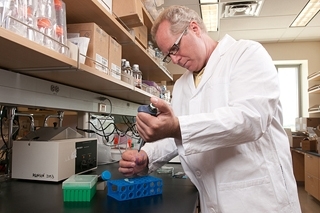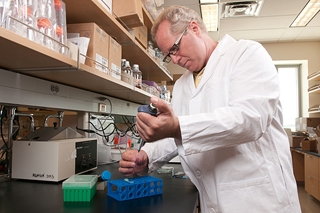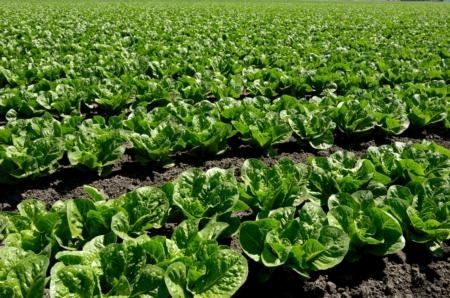Posts Tagged: e.coli
Science-based food safety tips

One of the events that attendees could sign up for was lunch with a scientist at The Ohio State University, located a few miles away from the conference venue. I chose Prof. Jeffrey LeJeune, an infectious disease microbiologist and epidemiologist, because a focus of his research is food safety, one of the topics included in the UC Global Food Initiative that UC President Janet Napolitano launched on July 1.
On the day of the luncheon, a Sunday, we were driven to The Ohio State University in buses the university provided. We assembled in the lobby of the Ohio Union (it was homecoming on campus and the Columbus marathon was in progress nearby), and were soon escorted to the tables of the scientists we had picked. The university kindly (and safely!) provided lunch.
At LeJeune's table, we introduced ourselves to one another. LeJeune began his presentation to his 15 guests by rebuffing the five-second rule. According to this rule, food dropped on the ground will not become contaminated with bacteria if it is picked up within five seconds of being dropped. LeJeune said it does not work. “Eating off the floor violates all food-borne illness prevention advice,” he warned.
Perhaps because we in his audience were all science writers, he proceeded to discuss communication challenges facing scientists. He said most of the emphasis in graduate training is on making discoveries, with hardly any attention paid to communicating these discoveries in lay language to benefit the general public. Other challenges he mentioned are the information explosion we are witnessing, resulting in deaf ears turned to many scientists' voices; and language barriers between scientists and journalists that hinder effective communication.

“The pasteurization of milk was a huge benefit to the health of the human population,” he said. “Most cheeses in the U.S. are pasteurized cheese products.”
We asked him many questions. He answered them all. He explained that the U.S. has the safest food supply. Despite this, pathogens can enter the food chain through live animals, he cautioned. Further, refrigeration could be inadequate. He said about 80 percent of food and vegetable contamination occurs post-farm. His tip for what to eat when traveling: “Avoid raw or unpeeled foods. It is best to choose what is fully cooked and hot.”
LeJeune noted there is no evidence to suggest that GM foods are problematic from a food safety perspective.
“There are some concerns for sure,” he said. “But these are largely economic or political. Nutrition-wise, GM foods can be beneficial. From a food safety and nutritional standpoint, I also see no significant differences between organic produce and non-organic or regular produce. There could be, however, some environmental impacts related to the different production systems.”
More questions followed. A discussion on E. coli bacteria gathered momentum, specifically how E. coli gets infected with a virus and how, when this virus decides to leave E. coli, it releases Shiga toxins, which, in turn, damage cells lining the kidney.
We were so engrossed in the discussion that it came as a surprise when one of the organizers of the luncheon strode into the room to inform us that our hour with the scientist was up and that the bus that had transported us to The Ohio State University was about to leave.
As we rose hastily from our chairs we thanked LeJeune for his presentation, which was clear and to the point – qualities all science (and other) writers appreciate. We know he had other topics to discuss with us: Can I cook my Jack-o'-Lantern after Halloween? (The answer is “Not if it sits out for more than two hours.”) And are raw diets for dogs a public health concern for humans? (The answer is “Your dog is more likely to have Salmonella if it is eating raw food.)
Although we didn't get to these topics, he left us with ample useful information about food safety. On the ride back to the conference, the bus was loud with conversation from the various lunch groups – what had been learned, how best it could be communicated, and how each one of us had made a new friend at the university.
La enfermedades causadas por alimentos contaminados y el Proyecto 100 K Genome

Bart Weimer, profesor de la Facultad de Veterinaria de UC Davis, funge como director del Proyecto 100,000 Genomas (100K Genome Project) y como co director de las recientemente establecidas instalaciones de BGI@UC Davis , donde se llevará a cabo la secuenciación. Otros colaboradores incluyen al los Centros para el Control y Prevención de Enfermedades de EUA (CDC )y el Departamento de Agricultura de EUA.
El nuevo proyecto de patógenos microbianos de cinco años se enfoca en hacer más seguro el suministro alimentario para los consumidores. El grupo elaborará una base de datos público y gratuito, incluyendo la información de secuencia para el genoma de cada patógeno — la colección completa de su información hereditaria. La base de datos contendrá los genomas de importantes patógenos de los alimentos incluyendo Salmonella, Listeria, y E. coli, así como los virus más comunes que contaminan alimentos y agua y causan enfermedades a las personas y animales.
El proyecto aportará el camino para el desarrollo de pruebas para identificar a los patógenos y ayudar a rastrear sus orígenes de manera más rápida. La nueva base de datos de genomas también permitirá a los científicos hacer descubrimientos que puedan ser usados para desarrollar nuevos métodos para el control de bacterias que causan enfermedades a través de la cadena alimentaria.
"Este histórico proyecto revolucionará nuestro entendimiento básico de estos microorganismos que causan enfermedades", dijo Harris Lewin, vice canciller de investigación en UC Davis.
El proyecto de secuencia es urgentemente importante para atacar los continuos brotes de enfermedades por alimentos contaminados que con frecuencia tienen resultados fatales alrededor del mundo. En los Estados Unidos solamente, enferman 48 millones de personas por intoxicación alimentaria anualmente y de las cuales mueren 3,000, según información de CDC.
"La falta de información sobre los genomas bacterianos relacionados con los alimentos está dificultando la habilidad de la comunidad investigativa para mejorar la seguridad del suministro alimentario mundial", señaló Weimer. "La información provista por el Proyecto 100,000 Genomas, permitirá que las pruebas de diagnostico sean más rápidas, más confiables, exactas y rentables".
"Vemos este proyecto como una forma de mejorar la calidad de vida para una gran parte de personas, a la vez que minimizamos un gran riesgo empresarial para productores y distribuidores de alimentos", manifestó Mike McMullen, presidente de Agilent’s Chemical Analysis Group.
Un artículo dirigido a los consumidores sobre el proyecto está disponible en sitio Web de la FDA .
(Este artículo es un condensado de un comunicado de prensa emitido por UC Davis. Lea el comunicado de prensa completo haciendo clic en press release y vea el video de Bart Weimer dando una visión general del proyecto).
Foodborne illnesses and the 100K Genome Project

Bart Weimer, professor in the UC Davis School of Veterinary Medicine, serves as director of the 100K Genome Project and co-director of the recently established BGI@UC Davis facility, where the sequencing will be done. Other collaborators include the U.S. Centers for Disease Control and Prevention and the U.S. Department of Agriculture.
The new five-year microbial pathogen project focuses on making the food supply safer for consumers. The group will build a free, public database including sequence information for each pathogen's genome — the complete collection of its hereditary information. The database will contain the genomes of important foodborne pathogens including Salmonella, Listeria, and E. coli, as well as the most common foodborne and waterborne viruses that sicken people and animals.
The project will provide a roadmap for developing tests to identify pathogens and help trace their origins more quickly. The new genome database also will enable scientists to make discoveries that can be used to develop new methods for controlling disease-causing bacteria in the food chain.
"This landmark project will revolutionize our basic understanding of these disease-causing microorganisms," said Harris Lewin, vice chancellor for research at UC Davis.
The sequencing project is critically important for tackling the continuing outbreaks of often-deadly foodborne diseases around the world. In the United States alone, foodborne diseases annually sicken 48 million people and kill 3,000, according to the CDC.
"The lack of information about food-related bacterial genomes is hindering the research community's ability to improve the safety and security of the world food supply," Weimer said. "The data provided by the 100K Genome Project will make diagnostic tests quicker, more reliable, more accurate and more cost-effective."
"We see this project as a way to improve quality of life for a great many people, while minimizing a major business risk for food producers and distributors," said Mike McMullen, president of Agilent’s Chemical Analysis Group.
A consumer-focused article about the project is available on the FDA website.
(This article was condensed from a UC Davis news release. Read the full press release and watch a video of Bart Weimer giving an overview of the project.)
La investigación ayuda a prevenir la contaminación de verduras frescas de hoja verde
Hace cuatro años, un brote de E. coli 0157: H7 en espinacas frescas asoló la nación. Alrededor de 200 personas en 26 estados se enfermaron; dos ancianas y un niño de 2 años de edad murieron.
El brote fue también devastador para la industria. La espinaca contaminada fue rastreada a la región del centro de California, donde los agricultores producen el 80 por ciento de las verduras de hoja verde en toda la nación. Científicos, agricultores y reguladores trabajaron juntos para restaurar la confianza del público en productos que son ampliamente considerados parte de una alimentación saludable. Los reguladores y productores crearon el California Leafy Green Marketing Agreement (Acuerdo de Mercadeo de Verduras de Hoja Verde en California), con el propósito de establecer una cultura de seguridad alimentaria en las granjas que producen verduras de hoja verde; por su parte, los investigadores aplicaron el conocimiento científico para detectar el origen del E. coli 0157:H7 en la región.
En el 2006, la Universidad de California y el Departamento de Agricultura de los Estados Unidos estaban diseñando un estudio de cuatro años para averiguar las posibles fuentes de E. coli 0157: H7, cerca de los campos de frutas y verduras en la región Central de California cuando el brote en la espinacas ocurrió. En este mes llega a su fin la etapa de recopilación de información de muestras en terrenos de pastoreo, campos de cultivo, arroyos y canales de riego. Ahora el equipo de científicos está analizando la información para obtener las conclusiones que ayudarán a prevenir contaminación de alimentos en el futuro.
De acuerdo a Edward (Rob) Atwill, investigador especializado en enfermedades transmitidas por agua contaminada en la escuela de Medicina Veterinaria de UC Davis, y uno de los investigadores principales del estudio, los resultados preliminares muestran una variedad de portadores de E.coli 0157: cerca de granjas en la zona central costera. En un principio, se implicó a cerdos ferales asilvestrados como portadores de la bacteria mortal. Sin embargo se ignoraba si había otras fuentes de contaminación en el medio ambiente. De manera que los investigadores recopilaron 1,233 muestras de excremento de animales silvestres y ferales de 38 ranchos de ganado y granjas productoras de verduras de hoja verde cercanas a hábitats de bosques ribereños, praderas y bosques de robles; se encontraron dieciocho muestras contaminadas con E. coli 0157:H7.
Los científicos encontraron la bacteria en:
3 de 60 pájaros tordos
5 de 93 cuervos americanos
2 de 95 coyotes
1 de 72 ratones de bosque
10 de 200 puercos salvajes
No se encontró el E. coli 0157:H7 en los excrementos de venado, zorros, mapaches, zorrillos, zarigüellas, ardillas de tierra y otras especies de pájaros y ratones.
“Nuestra meta para los próximos nueve meses es terminar de analizar todos los datos recopilados, que son bastante amplios y exhaustivos, e identificar varias prácticas agrícolas buenas que ayuden a reducir el riesgo de patógenos contaminantes en los alimentos para el sector de frutas y verduras frescas”, dijo Atwill.

La investigación ayuda a prevenir la contaminación de verduras frescas de hoja verde.
Preparado por Jeannette E. Warnert
Adaptado al español por Norma De la Vega
Research helps ensure safety of leafy greens
Four years ago, a multi-state outbreak of E. coli O157:H7 in fresh baby spinach gripped the nation. Nearly 200 people in 26 states came down with the disease. Two elderly women and a 2-year-old boy died.
The outbreak was also devastating for the industry. The contaminated spinach was traced back to Central California, where growers produce 80 percent of the nation’s leafy greens. Scientists, farmers and regulators worked together to restore public confidence in products that are widely considered part of a healthy diet. Regulators and farmers created the California Leafy Green Marketing Agreement to establish a culture of food safety on leafy greens farms and researchers worked to close gaps in the body of scientific knowledge about the sources of E. coli O157:H7 in the region.
In 2006, UC and USDA researchers were already designing a four-year study of the possible sources of E. coli O157:H7 near Central California fresh produce fields when the high-profile spinach outbreak occurred. This month, data collection from rangeland and farmland, steams and irrigation canals comes to a close. The team of scientists is now analyzing the data to reach conclusions that will help prevent future food contamination.
Preliminary results reflect a diversity of E. coli O157:H7 carriers near Central Coast farms, according to Edward (Rob) Atwill, a UC Davis School of Veterinary Medicine specialist in waterborne infectious diseases and co-principal investigator of the study. Early on, free-ranging feral swine were implicated as carriers of the deadly bacteria, but it wasn’t known whether there were other sources in the environment. The researchers collected 1,233 samples of wild and feral animal scat from 38 Central Coast cattle ranches and leafy greens farms that were adjacent to riparian, annual grassland and oak woodland habitat. Eighteen of the samples were found to contain E. coli O157:H7.
The scientists found the bacteria in
- 3 of 60 brown-headed cowbirds
- 5 of 93 American crows
- 2 of 95 coyotes
- 1 of 72 deer mice
- 10 of 200 feral swine
E. coli O157:H7 was not found in scat samples from deer, opossums, raccoons, skunks, ground squirrels, or other bird and mouse species.
“Our goal over the next nine months is to finish analyzing this very large and comprehensive dataset and to identify various good agricultural practices that reduce the risk of foodborne pathogens for the produce industry,” Atwill said.

Research helps prevent contamination of fresh leafy greens.